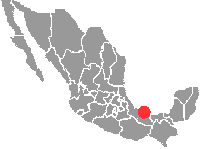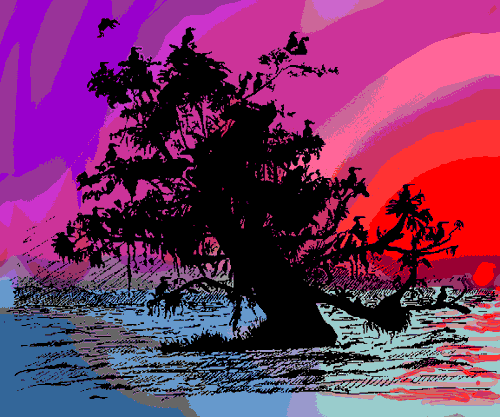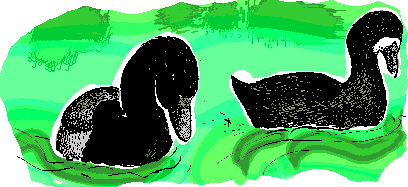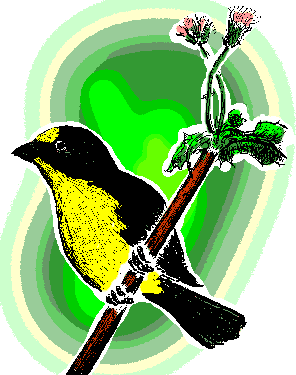LAGUNA CATEMACO
November 20, 1996
Notes from a birding trip
through Mexico by Jim Conrad
 Pickup trucks provide taxi service through the Sierra
Mazateca foothills. If you want a ride, you hold out your arm, ask the price to the next
town, and hop into the back. Sometimes you stand with others, holding onto the sideboards,
and sometimes there are board seats and a tarp cover. Some pickups run on schedule but
others run just when the driver is in the mood. Some drivers are friendly and
businesslike, others are surly, giving the impression that they're offended having to
stop. I'm deposited in Tuxtepec where regular bus service begins for the lowlands.
Pickup trucks provide taxi service through the Sierra
Mazateca foothills. If you want a ride, you hold out your arm, ask the price to the next
town, and hop into the back. Sometimes you stand with others, holding onto the sideboards,
and sometimes there are board seats and a tarp cover. Some pickups run on schedule but
others run just when the driver is in the mood. Some drivers are friendly and
businesslike, others are surly, giving the impression that they're offended having to
stop. I'm deposited in Tuxtepec where regular bus service begins for the lowlands.
I leave the state of Oaxaca and enter the state of Veracruz. Now the flat
land between villages and cities is occupied by banana and sugarcane
plantations, and weedy pastures with Zebu cattle attended by lots of Cattle
Egrets. Every inch of the landscape is occupied by settlements, intensively
cultivated plantations, pasture, or rampant weediness. People are everywhere, some
working, some lazing, many walking where there seems no place to go. I cross the Veracruz
lowland in a fugitive mood, hoping that by nightfall I can be someplace where I can peg a
tent.
Bus connections aren't so good so I take a series of slow local
buses from Tuxtepec to Cosamaloapan, then Tlacotalpan, then briefly quite near the Gulf of
Mexico to San Andrés Tuxtla, and, finally, late in the afternoon on a bus so broken down
and slow that it's really fun to lean back and gawk from the open windows, to Catemaco,
population 45,000. Catemaco is a tourist town on the edge of Laguna Catemaco;
"Laguna" means "Lake."
Especially in golden, late-afternoon sunlight it's a pretty region
with steep-sided, raggedly vegetated mountains, the Tuxtlas, rising beside the large lake,
which is roughly circular, and about 15 kms across (nine miles). I remember twenty years
ago having taken a gravel road along the lake's northern shore and now I want to revisit
that road, for I recall how wild it was, and I need to escape the tourist zone. On the
outskirts of town a cooperative of pickup-truck operators provides fairly regular service
along that road now. I hop into the back of a truck and ask the driver to drop me
someplace near the lake where I can camp.
At dusk I'm deposited in the village of Coyame, built at the
crossroad of the gravel road and a dirt road in pretty bad repair. The lake is a five
minute walk below town. Coconut Palms grace the shore and there are dry
sand rises perfect for a tent, with fantastic views across the lake. Among the populace
standing around looking at me I choose the most friendly looking, a woman shopkeeper
closing up her store. I ask if there's someplace where I might pitch a tent. She suggests
the very spot I've eyed. Since a dozen or so onlookers surround us all agree that it's a
good spot and that there's no problem with my staying there, I thank everyone and go
down to the palms, with maybe fifteen kids trailing and asking questions. Now the
community considers itself something of my guardian. Sometimes the opposite of secretness
is the best security, even when camping.
Approaching the lakeside I see the picture below, a Guiana
Chestnut out in the water near my tent site, with herons preparing to spend the night there.

In dusk's final glow I'm barely able to see where the tent goes. The
children leave when their mothers call. I enter the tent and zip up the door, leaving a
cloud of mosquitoes outside. Inside, I lie feeling the day's heat in the sand beneath the
tent's floor, listening to waves lap at the water's edge, still intoxicated by the view of
the heron-filled Guiana Chestnut, hardly able to wait until I awaken the next morning,
maybe with wild ducks right beside me.
BIRDS ALONG SHORE
At dawn it's not ducks but duck-like American
Coots, thousands of them fairly evenly spaced over the big lake's surface.
Coots are "duck-like" and not actually ducks, even though they float on the
water and almost look like ducks, because they're not in the Duck Family, the Anatidae.
Coots, being members of the Rallidae, are more closely related to cranes and
rails. Coots have lobed, not webbed toes, and their beaks are narrow, not flat, like a
duck's.
A floating mat of non-flowering Water Hyacinth
carpets about thirty feet of water next to shore and a unique but
absolutely-to-be-expected bird walks upon the hyacinth mat, pecking here and there,
looking for snails, aquatic insects and larvae, and an occasional small fish. It's the Northern
Jacana, the only Mexican member of its family, sometimes appearing as far
north as extreme southern Texas.

The special thing about the jacana is its feet, as you can see at
the right. These toes make sense, of course, because they distribute the bird's weight
evenly over a large surface area so as the bird forages atop floating vegetation, such as
waterlily pads, it's less likely to sink. Sometimes jacanas are called
"lily-trotters," or "lotus-birds." Here, despite their wonderful toes,
as they move across the water-hyacinth mat, as soon as they step on a plant the plant
begins sinking, so the bird is obliged to keep moving from one sinking plant to the next.
The jacanas aren't alone. A small flock of glossy-black Great-tailed
Grackles also treads atop the Water Hyacinths but, since they're far lighter,
they're not sinking. Neither are they as graceful as the jacanas. On level ground grackles
walk, not hop, but the water-hyacinth platforms are too irregular for walking so the
grackles clamber, jabbing their black, chisel-like beaks at snails wedged between bulbous
Water Hyacinth stems. The plants don't sink beneath the grackles' weight but they do twist
in the water, throwing the grackles off balance and causing them to continually and
ingloriously hold their wings and ample tails at the oddest angles.
Along shore a Green
Heron catches a slender, silvery fish, then flies with it in its beak to a
pole emerging from the water. The heron jerks its head to manipulate the writhing fish
into swallowing position, then the fish simply slides down the heron's throat. The heron
is left looking somewhat smug and the fish, just an instant ago full of life and silvery
brightness, is simply gone.
Men also are fishing at this break of dawn, their small, shallow
boats like the coots evenly spaced over the lake's surface, all at respectful distances
from one another, though from time to time they call across the water saying that the
fishing is no good today. The men stand in their boats casting large, circular nets. The
nets bear weights at their sides so they rapidly sink, then when the man pulls on the line
attached to the net's center the net closes like a hand.
One boat enters the lake late and makes its way along shore beside
me. A great mass of coots escape from the Water Hyacinths into deeper water. As they take
off, while flapping furiously they run for a distance atop the water, suggesting that
their bodies are too heavy for such pudgy wings to lift them into the air. The birds land
a long stone-throw's out, forming a dark, diffuse cloud of birds there. When the boat
passes, the birds make their way back into the hyacinths.
PIED-BILLED GREBES
For every 20 coots out there maybe there's one Pied-billed
Grebe. Though these two species share the lake's surface they're clearly
foraging for different foods, and thus their niches are not overlapping. In fact, coots
mainly eat aquatic vegetation, while grebes are almost entirely carnivorous,
mainly eating crustaceans such as crayfish, as well as small fish, mollusks, and aquatic
insects.
When coots dive they soon bob back to the surface near where they
disappeared but grebes remain submerged for 45 seconds and longer, usually resurfacing
surprisingly far from where they dove.
Though the coot's food obviously has much less nutritional value
than the grebe's high-energy carnivorous diet, my impression is that the coots spend less
time feeding than do the grebes As I scan Lake Catemaco's surface, every Pied-billed Grebe
seems hard at work alternating long dives with brief periods of catching breath, while a
large percentage of the coots are bathing, standing on Water Hyacinth rafts sunning
themselves, or just idly floating, looking around.
A Pied-billed Grebe pops to the surface and as it catches its breath
a Green Heron comes flying very low over the water with its legs
stretched forward, giving the appearance of being about to land atop the grebe. Neither I
nor the grebe can imagine what's on the heron's mind. The grebe submerges just long enough
for the heron to pass, then surfaces again, looks over its back, and I swear there's an
expression in its face, saying, "You fool!"
And how exquisitely grebes are adapted for their life in water. As
with coots, their toes are "lobed" with a series of flaps, so as they push their
feet backward against the water the flaps open up like oars, propelling the bird forward.
Then when the feet are drawn forward the flaps collapse and the water offers little
resistance. Grebe's toenails are even flattened, like little paddles, something very rare
among birds.
Moreover, a grebe's legs arise far back along its body. This makes
it hard for grebes to move on land but, in accordance with the laws of physics, it enables
the birds to harness a powerful forward thrust when diving. Like many birds highly adapted
to diving, grebes have difficulty lifting themselves from the water's surface. With
rapidly beating wings they taxi across the surface with their running legs frantically
providing extra propulsion below them, before becoming airborne.
LESSER SCAUPS
I'm surprised to find so few ducks here -- just a few
Lesser Scaups. My field guide's distribution maps indicated that several
species are to be expected here. Maybe other species arrived but saw all the coots and
just kept going.

One reason I've
been wanting to see ducks is that before my trip I was reading Paul A. Johnsgard's Handbook
of Waterfowl Behavior. Therefore, now the Lesser Scaup before me throws back its head
in a curious way and I recall that Johnsgard dignifies this blur of action with the name
of "head-throw display." He says that it lasts approximately 1/20th to 1/30th of
a second, and that the bill is thrown back less than 45 degrees, even though it appears to
reach almost the vertical. Head-throws are displayed by males to focus the female's
attention and convey the message that he's interested in her. Since it's such a brief
event it's always preceded by special "head shakes" conveying the message
"Pay attention, now, for I'm about to head-throw... "
Head-throws very similar to the Lesser Scaup's and with the same
message attached also appear among Greater Scaups, Canvasbacks, Redheads, and Ring-necked
Ducks -- all species so closely related to our Lesser Scaup that on occasion they
hybridize with them in the wild. Johnsgard makes the point that head-throws in Greater
Scaups are slower than in Lesser Scaups -- about 1/6th of a second instead of the Lesser
Scaup's 1/20th to 1/30th of a second.
COOT TUSSLE
Toward noon the lake becomes a broad, shallow saucer of placid,
shining quicksilver. The thousands of coots that earlier were dispersed across the lake's
surface have gradually coagulated into groups closer to shore and as time passes the
gatherings condense until finally they form tight knots keeping in sheltered bays. Having
them closer at hand I'm astonished at how much they eat -- swallowing entire sprigs of an
aquatic plant similar to the Elodea grown in home aquaria.
One coot latches onto a six-inch sprig too large to swallow and,
although all the coots in that group float in a morass of the plant, a neighboring coot
covets the large prize and rushes to rob it from the owner. A small contest erupts,
drawing attention of other coots, who rush to join the fray. In the end the sprig breaks
into several segments and no coot gets more than a modest snack.
BIRDLIST #12-a
Here's the Official List for birds seen on the lake, including atop
rafts of vegetation floating along its margins.
November 20:
latitude 18º26'N, longitude 95º01'WMEXICO: Veracruz; Laguna Catemaco, freshwater
lake and shore in vicinity of Coyame about 10 kms east of town of Catemaco, on north
shore; elevation about sea level and about 25 kms inland
RESIDENCY STATUS:
permanent resident
winter resident
- Pied-billed Grebe
- Lesser Scaup
- Osprey
- Great Egret
- Snowy Egret
- Great Blue Heron
- Green Heron
- Little Blue Heron
- Tricolored Heron
- American Coot
- Northern Jacana
- Laughing Gull
- Common Tern
- Belted Kingfisher
- Green Kingfisher
- Northern Waterthrush
- Great-tailed Grackle
In this list there's not a single bird not also
appearing in the US.
GUIANA-CHESTNUT GARDEN
Now I pack my tent into my backpack and begin working farther along
shore. In the afternoon I come to another Guiana Chestnut at the water's
edge. About 35 feet high, the tree's trunk is equipped with buttresses jutting from its
base like foot-thick, seven-foot-high rocket fins. The buttresses give the tree better
footing in soft mud.
This tree, like the one sketched in the lake where Great Blue Herons
and Great Egrets gathered, is nothing less that an airborne garden. Up close I can see how
the big herons and egrets can stand atop the trees' canopies as if they were on solid
platforms: Outermost twigs are thick and strong enough to make solid perches for big
birds.
Inside the tree these coarse twigs are encrusted with the following:
- thick mats and dangling festoons of succulent, yellow-green peperomias
with cream-colored spikes dusted with pollen, with succulent
- viney anthuriums with arrow-shaped, waxy leaves two
and a half feet long
- Night-blooming Cereus cactus with red, radish-like
fruits along their flat, tongue-like blades
- Rhipsalis cactus with round stems thinner than
pencils dangling in clusters like upside-down candelabras, some of their stems ending in
white, succulent, pea-size fruits'
- a fern with fronds over three feet long
- gray bromeliads no larger than the nest of a warbler, other
bromeliads with coarse, strap-shaped blades bigger than a bushel basket
- gray lichens and moss
- small orchids with green leaves, white roots, some of them with
leaves like blades of grass, other species with broad, leathery leaves, some with bulbous
pseudobulbs at their leaf bases, but not a single one in the whole tree blossoming at this
time...
Deep within the Guiana Chestnut's shadowy interior I spot White-eyed
Vireos and Black-and-white Warblers. I'm accustomed to seeing
the warblers in northern forests where they glean tiny arthropods from the bark of tree
trunks and branches rather like nuthatches. Here they do the same thing, but inside the
big tree they glean aroid stems, and the stipes of long, cascading ferns.
The tree bears abundant chestnut-brown, spherical fruits nearly the
size of basketballs. I wonder what caused these fruits to evolve to be spherical and so
large. Here the fruits fall into the mud, the thin brown rind splits and several
lemon-size seeds are released.. At first the seeds are encased in whitish, cellophane-like
membranes. These tear away leaving the seeds looking like bright green gobs of partially
melted plastic with deep furrows in the shape of stars with four slender arms.
More often than not the seeds pile up at the water's edge,
germinating in soggy, wind-heaped-up piles of decaying Water Hyacinth and other aquatic
vegetation. All or nearly all of the seedlings must die, for I find no saplings in the
area.
Much impressed by this tree, though the place strikes me as being
particularly snaky, I peg my tent inside an angle formed by two of the tree's flaring
buttresses.
At dusk, behind the netting of my tent door and thus safe from the
hoards of mosquitoes, it's a cozy nest with a view of the setting sun. Two Northern
Waterthrushes come sauntering along the water's edge, flipping wet leaves,
bobbing their tails, and teetering together as two waterthrushes should. A little later a
pair of Plain
Chachalacas glides into the dense tangle of branches not twenty feet above
me. As they move toward one another after landing I hear them purring like big cats, and
see their archaeopteryx-like silhouettes stealthily coming together.
All night I sleep with waves breaking so nearby that they splatter
my tent.
BIRDLIST #12-b
Here's the Official List for the next day's birds seen as I hike the
gravel road skirting the lake and headed eastward.
November 22:
latitude 18º26'N, longitude 95º01'W MEXICO: Veracruz; Laguna Catemaco, along 10
kms of gravel road east of Coyame, which is about 10 kms east of the town of Catemaco;
this is the northern shore; roadside, woods and pastures; elevation about sea level and
about 25 kms inland
RESIDENCY STATUS:
permanent resident
winter resident
not found in the
USA
- Black Vulture
- Turkey Vulture
- Roadside Hawk
- Plain Chachalaca
- Cattle Egret
- Plain-breasted Ground-dove
- White-fronted Parrot
- Blue-crowned Motmot
- Keel-billed Toucan
- Golden-fronted Woodpecker
- Great Kiskadee
- Rose-throated Becard
- Brown Jay
- Band-backed Wren
- Blue-gray Gnatcatcher
- White-eyed Vireo
- Black-and-white Warbler
- Hooded Warbler
- Magnolia Warbler
- Wilson's Warbler
- Yellow-throated Warbler
- Yellow Warbler
- American Redstart
- Northern Parula
- Eastern Meadowlark
- Melodious Blackbird
- Montezuma Oropendola
- Great-tailed Grackle
- Yellow-throated Euphonia
- Blue-gray Tanager

One of the most exotic birds in the above list is the Blue-crowned
Motmot, pictured above. Notice how the long tails are missing barbs along
part of their lower lengths. This is typical of most motmot species. Blue-crowned Motmots
are fairly common in Mexico's humid Gulf lowlands, sometimes not very shy of humans. They
might appear in one's garden, or even at an overgrown trellis at a porch's corner.
 For
me, the list's most striking feature is that nearly a third of the species are warblers
and vireos from the north, spending their winter here.
For
me, the list's most striking feature is that nearly a third of the species are warblers
and vireos from the north, spending their winter here.
Still, even in this weedy, much disturbed environment there are
wonderful things northern birders never see, such as the Yellow-throated
Euphonia at the right. Euphonias are closely related to tanagers. This
species occurs in wet tropical forests and their borders, plantations and gardens from
Mexico's northern Gulf lowlands to Panama. It's a common species, but always nice to see.
Go to Stop 13
Return to Trip's Index Page
 Pickup trucks provide taxi service through the Sierra
Mazateca foothills. If you want a ride, you hold out your arm, ask the price to the next
town, and hop into the back. Sometimes you stand with others, holding onto the sideboards,
and sometimes there are board seats and a tarp cover. Some pickups run on schedule but
others run just when the driver is in the mood. Some drivers are friendly and
businesslike, others are surly, giving the impression that they're offended having to
stop. I'm deposited in Tuxtepec where regular bus service begins for the lowlands.
Pickup trucks provide taxi service through the Sierra
Mazateca foothills. If you want a ride, you hold out your arm, ask the price to the next
town, and hop into the back. Sometimes you stand with others, holding onto the sideboards,
and sometimes there are board seats and a tarp cover. Some pickups run on schedule but
others run just when the driver is in the mood. Some drivers are friendly and
businesslike, others are surly, giving the impression that they're offended having to
stop. I'm deposited in Tuxtepec where regular bus service begins for the lowlands.



 For
me, the list's most striking feature is that nearly a third of the species are warblers
and vireos from the north, spending their winter here.
For
me, the list's most striking feature is that nearly a third of the species are warblers
and vireos from the north, spending their winter here.